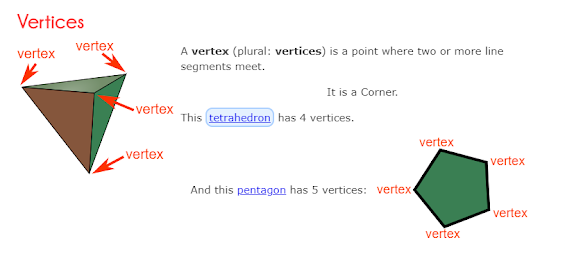Week 14 February 1-5/21
Want to wake up the brain? Try out this thinker.... 🤔
Click here ↴ or here →Which one doesn't belong?
Week 13 January 25 - 29/21
**There is no PDF available for this week**
This week we are focusing on Identify, create, and analyze single transformations of 2-D shapes (with and without the use of technology). (SS5.7)
Single Transformations of 2-D shapes reflection
Reflection: When a shape is reflected in a mirror we see a reflection image. The line segment that joins a point to its image is perpendicular to the line of reflection. A shape and its image have opposite orientations, or face opposite ways. A reflection is sometimes called a flip because when a shape is reflected, it is flipped over.
Single transformations of 2-D shapes - rotations
When we rotate an image, we turn a shape on a point of rotation. We can turn or rotate the image clockwise or counterclockwise. The point of rotation will be on one of the vertices of the shape.
Think about the hands on a clock. When the minute hand moves from the 12 to the 3, it rotates a quarter turn clockwise.
Week 12 January 18 - 22/21
SS 5.5 & 5.6
Terminology:
Edge: a line segment between faces.
Face: any of the flat surfaces of an object.
Vertex: the corner of an object
Side: In a 2 dimensional shape, one of the line segments, or edges, in a 3 dimensional shapes, one of the faces
Symmetrical: A shape is symmetrical when it can be folded so that one part matches the other part exactly. The fold line is the line of symmetry.
Look at the pictures below for further explanation.
Week 11 January 11 - 15/21
Attribute- a way to describe a shape.
Example: the lengths of the sides and parallel sides are two attributes.
Intersect- when two sides meet, they intersect at a point called the vertex.
Vertex- the point where two sides of a shape meet.
Parallel- two lines that are always the same distance apart and will never meet.
Online Assignment:
I can check my answer by substituting my answer for the variable.
3 + 2 = 5
If I get the right answer, then I know the value of the variable.
Week 9 - January 4 - 8 / 2021
368÷3=
300÷3=100
60÷3=20
8÷3=2 remainder 2
368÷3= 122 r2
Youtube - Math Antics Long Division Youtube - Long Division with Remainders
Online Assignment:
As I'm catching up to posting weekly, I am combining weeks in each post. Sorry for the inconvenience.
Week 7
"Breaking Apart" Strategy:
This multiplication Strategy has you breaking apart factors into smaller factors.
As you can see, the 8 is broken into two factors that still adds up to 8. You can split it any way you want. whichever is easier for you.2 x 4 x 5= Hold the 2 while you multiply 4 x 5= 20Now multiply the 2 with 20. It looks like this 2 x 20= 40
Watch the YouTube videoPractice with 9 x 7
Week 8
Area Model Strategy:
As I'm catching up to posting weekly, I am combining weeks in each post. Sorry for the inconvenience.
Week 7
"Breaking Apart" Strategy:
This multiplication Strategy has you breaking apart factors into smaller factors.
Area Model Strategy:
Week 6 November 16-20
**There is no printable copy for this week's learning package.
This week, the focus continues with multiplication. Start with Factoring and finishing off the week with Halving and Doubling.
Objective: Watch the video, then do the assignment right after.
Day 1
1. Factoring: Reviewing Multiplication
Online Assignment:
Day 2
2. Skip Counting for Multiplication
Online Assignment:
❇️ This strategy will only work if one or both factors are:
1. A even number OR
2. Ends with a 5 or 0.
- ex. The 4 is cutting in half to 2, then 2 is cutting in half to 1.
- At the same time, the 9 is doubling up to 18, then 18 is doubling up to 36.
Online Assignment:
2) Here are some example pages:
Probability 1 gives you the definition and some examples on how to understand outcomes of probability.
Probability 2 gives you information on probability range of "chance or likelihood".























No comments:
Post a Comment